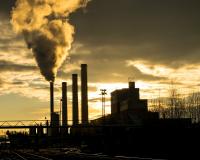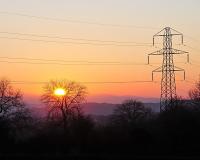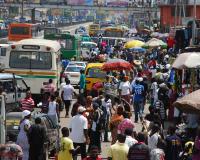
Vibrant Environment
All | Biodiversity | Climate Change and Sustainability | Environmental Justice | Governance and Rule of Law | Land Use and Natural Resources | Oceans and Coasts | Pollution Control

Throughout the month of July, ELI is taking a closer look at “Environmental Justice & Vulnerable Communities” as we continue to offer special events, programs, and publications in commemoration of our 50th Anniversary. As part of this month-long introspection into our work in environmental justice, Research Associate Lovinia Reynolds and Research and Publications Intern Anthony D’Souza reached out to Barry E. Hill, ELI Visiting Scholar and Adjunct Law Professor at Vermont Law School. Prior to coming to ELI, Professor Hill was the Senior Counsel for Environmental Governance at EPA’s Office of International and Tribal Affairs. From 1998 to 2007, he was Director of EPA’s Office of Environmental Justice. Below are Professor Hill’s thoughts and perspectives, as an environmental justice advocate, on environmental justice in the United States.

Would the formation of a regional power market in the western United States be a step forward into a more sustainable future or a stumble backward into continued use of fossil fuels for the region? Much of the debate concerns how a regional power market would increase or reduce greenhouse gas (GHG) emissions. Advocates of the regional power market argue that with increased use of renewable energy and its more efficient integration and transfer, carbon emissions would decrease. In contrast, proponents against the new framework maintain that less state control over their energy grids could result in less support for renewable energy and an increased use of coal. The formation of this market could lead to a cleaner, greener future or it could incentivize continued use of fossil fuels within some of the western states.

Does “meat” have to come from a living, breathing animal? According to proponents of cellular agriculture, this may not always be the case. This new industry aims to produce “meat” by growing animal cells outside of a living body, envisioning a future where humans can consume beef, pork, chicken, and seafood without having to slaughter a single animal. The process of producing such cell-based food involves taking cells from a live animal and using a growth medium to grow the cells into large, edible tissue. In recent years, this technology has generated public excitement, attention, and, most importantly, investment. However, regardless of what the products of cellular agriculture look like or when this technology will be fully developed, naming this product is much more complicated.

Over the last several decades, many countries have sought to decrease their carbon footprint by creating stricter emissions standards for motor vehicles. However, once these standards are in place, a serious question arises: what should be done with older, “dirtier” vehicles? Often, the answer has been to export them to regions with less strict vehicle standards.

Carbon capture and storage (CCS) is a hot-button topic as a strategy to mitigate climate change and reduce greenhouse gas emissions. CCS entails capturing carbon dioxide from the atmosphere and industrial plants at the source, then injecting the captured carbon dioxide into underground geologic formations for storage. Much research has focused on sequestering carbon dioxide onshore, in depleted oil and gas reservoirs or deep saline aquifers. Offshore CCS also may be feasible, but presents several governance and legal challenges.

Climate change threatens to dramatically increase inequality and create greater hardships for women and girls, in large part because of their disproportionately vulnerable economic, social, and political positions worldwide. Food shortages disproportionately affect the health of women and girls, and in many regions, women are more directly dependent on natural resources threatened by climate change for their livelihoods. For instance, a U.N. report observed that in developing countries, women account for 45-80% of all food production, and about two-thirds of the female labor force is engaged in agricultural work. In such developing regions, women face unique vulnerabilities from the increasing unpredictability of food sources as well as the loss of income or jobs if agricultural resources are impacted by climate change.

When’s the last time you found yourself idly shopping out of boredom or buying a shirt just because it was on sale? If it was in the last week, then you’re not alone. The average American shopper buys 60% more clothing today than they did just 15 years ago, but keeps it for only half as long. At the end of the year, this results in approximately 80 pounds of unwanted clothing per person!

Frustrated by some states’ use of their Clean Water Act (CWA) §401 authority to oppose or delay energy projects—particularly the transportation of fossil fuels—the Trump Administration issued the second installment in its efforts to restrict that authority on June 7. The U.S. Environmental Protection Agency’s (EPA’s) Clean Water Act Section 401 Guidance for Federal Agencies, States and Authorized Tribes strictly interprets state deadlines under §401 and takes a narrow view of the grounds on which states may deny or condition their approval of projects. The guidance follows an April 10 executive order, and will be followed in August by proposed EPA rules, with final rules by May 2020.

Several cases before the U.S. Supreme Court this term touched environmental law, ranging from jurisdictional disputes over a state’s right to ban uranium mining to whether state or federal laws apply when hunting moose from a hovercraft along an Alaskan river. An unusual amount of cases navigate the intersection of environmental regulations and tribal sovereignty, the Court so far siding with tribes on the issues of state fuel tax exemptions and hunting rights. One pending case, Carpenter v. Murphy, is not explicitly environmental, but the answer to its core question has potentially seismic environmental implications: is the eastern half of Oklahoma still, technically, an Indian reservation? While the case primarily involves criminal jurisdiction, the degree to which the Court accepts or rejects this question may alter taxation, regulation, and even ownership of one of the most energy resource-rich regions in the country.

With the help of the U.S. Congress, the U.S. Department of the Interior (DOI) has had a long and proud history of tackling pressing challenges through responsible and inclusive management of America’s public lands. One might expect it would continue that tradition as climate change has become a major challenge confronting the nation.